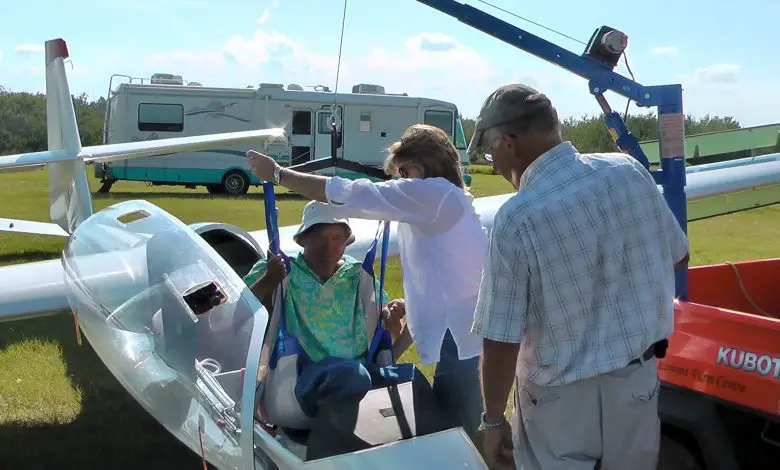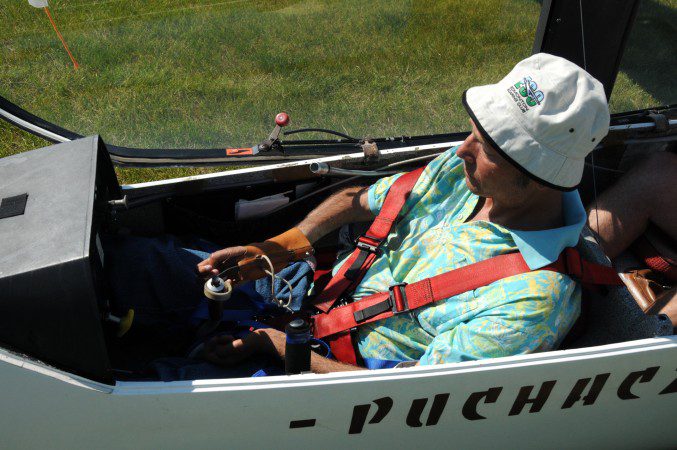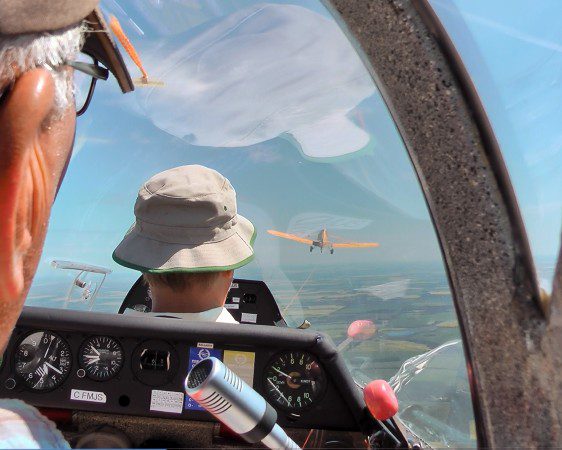
The freedom of flying with a disability
Kary Wright is a 49-year-old married father of two and a c5/c6 quadriplegic. Having shared his experiences of fishing with a disability, he talks about one of his other outdoor passions, flying.
“So, how about a little wing over?” Asks Bob Hagan from the back seat.
“Sounds good to me!” I reply.
“Okay, now follow along with me,” says Hagan as he instructs me to keep my hand on the control stick so that I can learn the maneuver.
Bob points the nose down and we quickly accelerate, trading altitude for speed. He then raises the nose sharply and the G forces push me down into the seat. We are ascending a near vertical climb, then suddenly he kicks the rudder to the left. The nose then drops through the horizon and we free-fall straight down, what a rush!
Now my turn. I push forward on the stick to point the nose earthward so that we can gain speed, then I pull back into a steep climb and move the stick left to roll us onto our side. Again the nose falls through the horizon and I level the wings and pull out of the dive. What an amazing feeling of freedom!
I have been a quadriplegic since a 1986 automobile accident. Before my accident I used to fly fixed wing aircraft privately, but have only been in an aircraft a couple of times since. Then a couple of years ago I noticed an article about people with disabilities flying gliders. I made a few calls around the local clubs and found out that some of them were equipped to handle people with disabilities, a whole new world suddenly opened up to me.
Once you are bitten by the flying bug, I think the disease is always in there. It didn’t take long for the fever to take over, just like it did when I was a teenager. The clubs here use a simple hoist lift on the side of an all-terrain vehicle to lift me into the glider.
Once inside I can grab the joystick using a cuff that we have designed ourselves. Then I am strapped in with the seat belt and shoulder harness and a brave instructor jumps in the backseat to help with the take off, and is always there to back me up if need be. We are towed to an altitude of 3000 feet above ground, the trickiest part of the flight. Once we are released from the tow plane I can take over full control of the aircraft including the landing.
We fly around for approximately 30 minutes, looking for lift. Thermals, which are columns of air that are formed by the ground being heated from sunlight, are rising. In spring weather we get lots of thermals and hence flights of several hours are possible, but in the heat of the summer the lift is not as available and most flights last from 30 minutes to one hour.
At 1,000 feet above ground we join the circuit on the downwind leg. I fly parallel to the runway while watching it out my left side. Hagan in the back seat is running the spoilers for me, as they aren’t adapted and are hard for me to reach. The spoilers increase our rate of descent so that we will come down quickly and use very little runway.
As we get close to the ground, the runway seems to flatten out. I pull back on the stick gradually and level out just a foot or two above the ground. We go zooming past parked gliders, automobiles, and my lonely wheelchair is sitting there by itself. The glider gently settles so that the tail wheel starts skimming the grass, and were back on the ground!
“Good landing!” says Bob.
“All right!” was my exited reply!
Another club member comes driving up in the all-terrain vehicle to tow us back to the starting line.
“Are you ever going to get out of that thing?” Asks Conrad; teasing me because it is my third flight already today.
“Nope, we put contact cement on the seat before I got in. I traded you guys my wheelchair for this thing!” I replied.
“Well you might have trouble getting that thing in the kitchen with its wings on!” was the reply.
Gliding is something that takes very little physical strength, and I think most folks with disabilities can fly these. Even if you can’t fly them yourself, you can always go for a ride. Gliding clubs are very friendly and accommodating – most clubs are happy to do whatever it takes to get us in the air. I live in Canada, but I know there are clubs all over North America and Europe that will accommodate people with disabilities, and there are more and more gliders being built that have hand controls.
Gliding has opened a new world for me, for years I never thought I would be back in the air but now I know that it is available to almost everybody. Check out your local gliding club, I think you will find a bunch of very friendly and accommodating people that will do what they can to help you to enjoy their favourite sport!
By Kary Wright
Read Kary’s article about adaptive fishing, and check out our Sports section for more like this.
Do you have a local gliding club, or adaptive sports facility? Let other Disability Horizons readers know by emailing us at editor@disabilityhorizons.com, tweeting us at @DHorizons or messaging us on Facebook.

